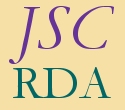

To print, use the PDF version.
1 November 2007
A Strategic Plan was first developed for AACR in 2002. It has been revised each year since then and is reviewed annually.
The current Strategic Plan has been further revised to reflect goals and strategies for the development of RDA-Resource Description and Access.
The Joint Steering Committee and the Committee of Principals share overall responsibility for the plan. The JSC, the CoP, the Co-publishers, the RDA Project Manager, the RDA Editor and the JSC Chair each have responsibilities in relation to specific aspects of this plan.
STATEMENT OF PURPOSE FOR RDA
RDA - Resource Description and Access will be a new standard for resource description and access, designed for the digital world.
Built on foundations established by the Anglo-American Cataloguing Rules (AACR), RDA will provide a comprehensive set of guidelines and instructions on resource description and access covering all types of content and media.
RDA will enable users of library catalogues and other systems of information organization to find, identify, select, and obtain resources appropriate to their information needs.
Return to Top of Page
LONG TERM GOALS FOR RDA
1. The guidelines and instructions in RDA will be designed to:
- Provide a consistent, flexible and extensible framework for both the technical and content description of all types of resources and all types of content.
- Be compatible with internationally established principles, models, and standards.
- Be usable primarily within the library community, but be capable of adaptation to meet the specific needs of other communities.
2. Descriptions and access points produced through the application of RDA guidelines and instructions will:
- Enable users to find, identify, select, and obtain resources appropriate to their information needs.
- Be compatible with those descriptions and access points devised using AACR2, and present in existing catalogues and databases.
- Be independent of the format, medium or system used to store or communicate the data.
- Be readily adaptable to newly-emerging database structures.
3. RDA will be developed as a resource description standard that is:
- Optimised for use as an online tool (although a print edition will also be published).
- Written in plain English, and able to be used in other language communities.
- Easy and efficient to use, both as a working tool and for training purposes.
Return to Top of Page
STRATEGIES FOR ACHIEVING THE GOALS 2005-2009
1. To ensure that the guidelines and instructions in RDA meet the goals for consistency, flexibility, etc., outlined under Goal 1 above, we will:
- Resolve problems associated with the class of materials concept and the related issue of GMDs.
- Resolve residual problems associated with cataloguing resources that change over time, including multipart resources.
- Revise and modernise terminology to eliminate unnecessary library jargon, and eliminate ambiguous and inconsistent terminology.
- Extend consistency within the technical and content description, and eliminate unnecessary redundancy.
- Review and update the examples throughout RDA.
- Include a statement of the principles of RDA, and a description of the functions of the catalogue, and relate these to the Statement of International Cataloguing Principles.
- Align the structure, concepts and terminology of the instructions more directly with the Functional Requirements for Bibliographic Records (FRBR) and Functional Requirements for Authority Data (FRAD) models.
- Improve the coverage of materials such as digital resources, three-dimensional objects, visual materials, manuscripts and archives.
- Identify and actively involve other resource description communities and other stakeholders in the development of RDA in accordance with the RDA communication plan.
- Consult with other communities (archives, museums, publishers, educators, book dealers, ILS vendors, etc.) in an effort to attain effective levels of alignment between RDA and the metadata standards used in those communities.
2. To ensure that descriptions and access points produced through the application of RDA meet the goals for functionality, compatibility, etc., outlined under Goal 2 above, we will:
- Directly relate the elements of the description and access points to the user tasks that they support.
- Revise the instructions to facilitate collocation at the FRBR work and expression levels.
- Incorporate the concept of authority control.
- Revise the instructions relating to the choice of access points to address issues associated with the concept of “authorship” as it is currently reflected in AACR2 and restrictions imposed by the “rule of three”.
- Separate instructions on the recording of data from those on the presentation of data.
3. To ensure that RDA is developed as a resource description standard that meets the goals for ease and efficiency of use outlined under Goal 3 above, we will:
- Work with an online product developer to develop an online tool according to functional specifications that reflect how RDA will be used.
- Provide conceptual background within RDA to assist the user of the instructions to understand the process to be followed.
- Write new text in plain English, and revise existing text wherever practicable.
- Provide a revised Glossary, and incorporate definitions into the text where needed.
- Consult with educators and trainers, and plan for activities that support the implementation of RDA.
4. To ensure that RDA is ready for release in 2009, we will:
- Develop, implement and maintain a Business Plan.
- Establish an effective project management structure, including the appointment of a project manager.
- Balance community input with the need for RDA to be ready for publication within the timeframe.
- Employ appropriate risk management processes.
Return to Top of Page
|


